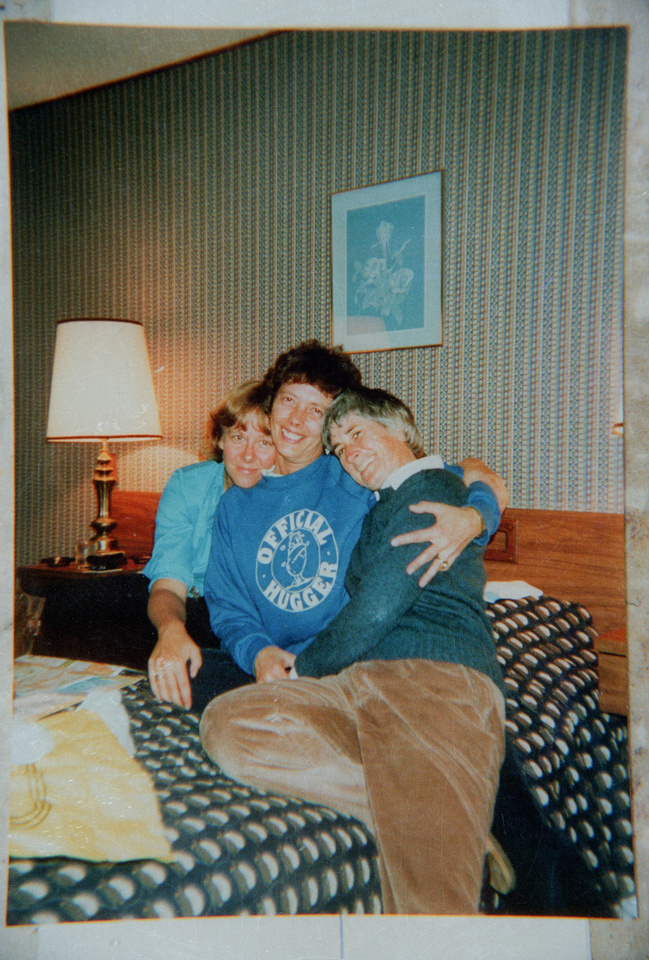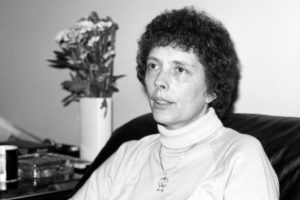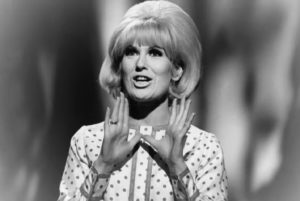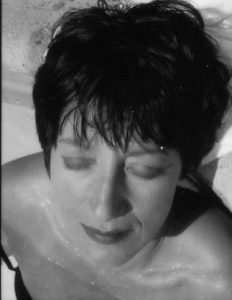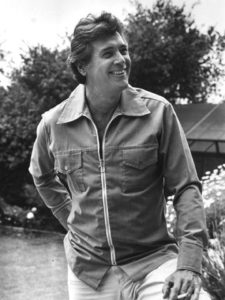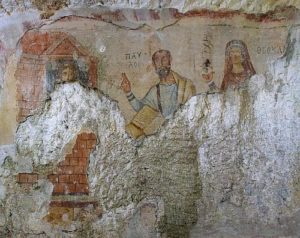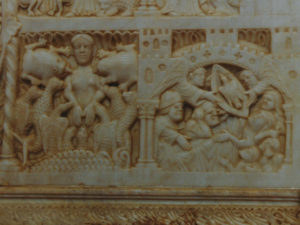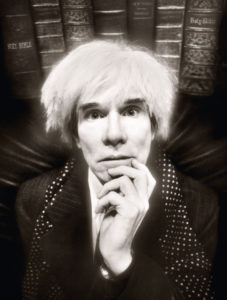Posted in category "Arts & Letters"
Pat Turner and Kim Stabinski
All the Gay Pride and social media coverage in June prompted me to reflect on my own activism and remember good friends. Back in the 1980s, when the Conference for Catholic Lesbians (CCL) was in full force growth mode, Pat Turner was the editor of our quarterly newsletter, Images. Pat stepped up to take on the role when we needed a person with experience and professionalism. Years before, Pat had served as an editor and production volunteer for the Daughters of Bilitis’ newsletter – The Ladder.
The Daughters of Bilitis
The Daughters of Bilitis, also known as “DOB” or “Daughters,” was the first lesbian civil and political rights organization in the United States. According to legend, Bilitis was the lover of Sappho, a renowned Greek lyric poet. DOB was founded as a social and activist group by four women in San Francisco in 1955. Some of the founders wanted to remain a social group, but others wanted to agitate for lesbian rights, respect, and equality. The activist group prevailed. (The opposite eventually happened with CCL – the social group prevailed.) Both groups died out due to lack of volunteers, and an inability to reconcile original founding goals with evolving cultural changes. Living a lesbian lifestyle became more accepted and affirmed as the US became increasingly secular and shifted away from its larger Judeo-Christian religious participation.
Tall with curly brown hair, Pat Turner is a very attractive woman. She was a steady presence and spoke in a reasoned and calm way. Pat had a very gracious way of speaking and disagreeing; so she could bridge disagreements and manage deadlines without ruffling feathers. When she was a young woman, she had joined a religious community, but left after a year or two. When I met her in the mid-1980s, Pat was an executive in the insurance industry and living in Florida. She had previously been in a long-term relationship, but her partner had passed away.
Lesbian Roles
Pat talked to me about her DOB days and what lesbian life was like at that time. Women usually identified themselves as “butch” or “femme.” Pat was femme. I told her I couldn’t identify with either group. She told me that I would have been kiki (the “i” pronounced like “eye.”) The term “kiki” was generally in existence from the 1940s-1970s and described a lesbian who did not identify as either butch or femme and was both passive and active sexually. Butches were active and femmes were passive. I didn’t like the butch/femme vibe, gender roles, or the idea of not having a complete sex life, so being a kiki outlaw was fine with me.
An Unexpected Gift
Pat gave me an unexpected gift. It was a handwritten letter on the last piece of stationery she had from her DOB days. The name at the top of the paper was Kim Stabinski. Many DOB leaders used assumed names to protect themselves from threats and harassment. I remember that I asked her how she chose that name, but I can’t remember her answer. I treasured that letter as a piece of lesbian history from a friend who helped to make that history. I included it with my CCL papers, photos and memorabilia that are now housed in the Marquette University archives.
Pat recorded her memories as part of the Daughters of Bilitis Video Project by the Lesbian Herstory Archives in New York City. Pat’s interview was taped on December 31, 1987. I listened to part of her interview as I was preparing this post. It was lovely to see her and hear her voice again. Pat was mentioned in the Lesbian Herstory Archives Newsletter, #10, February 1988, as part of the East Coast DOB. Her name was noted Pat Turner (Kim Stabinski).
I looked at the August/September 1969 issue of The Ladder, and there was Kim Stabinski on the masthead. Kim Stabinski authored an article in the December/January 1970-1971 edition, “The Roman Catholic Lesbian – The Old Order Changeth.” The article is eight pages long (page 15-22) and can be read in its entirety here.
Searching for Inner Peace
There are two sections in her article that were particularly moving. One involves Catholic Lesbians and their choices about attending Mass and receiving communion; the second described an encounter with her priest and her lover. They took place in the 1960s but could easily have happened today.
“So I sat in Mass Sunday after Sunday,” she begins, “watching – often with tears – others receive the sacraments denied me. I watched my Catholic Lesbian friends: the ones who had given up completely and never attended Mass, the ones who scraped in one furtive confession a year around Easter and avoided thinking of the shut door the rest of the time, and the ones who, like me, kept going but were strangers in their own Church. Then there were the few who were apparently good practicing Catholics, attending Church regularly and receiving the sacraments while continuing to live a Lesbian life. Notable in this group were two women who were very “married” and had been for a good many years.”
“In this latter group but distinctly different were a few who attended Mass and received communion regularly without confession – a real anathema in the Church’s eyes…They had managed to rationalize in their own hearts their defiance of the legalistic Church, but acceptance of the sacraments Christ intended them to have, even though these sacraments were coming through a Church that said they had no right to them. I envied them, too – I envied their courage to trust in God’s love alone, to defy the Church that said they were “eating their condemnation” by receiving communion “unworthily.”
Longing for Communion
In November of 1969, Pat Turner said that she made one last attempt to reconcile herself and her Catholic faith. She sought out a priest at her parish and set up a schedule for counseling. “At our first session I told Father my vastly-opposed-to-Catholic views on Lesbian expression in a real love relationship. I described the emotional relationship I share with my beloved (a Catholic, by the way, of the non-confession weekly communion clan), explaining that neither of us would degrade our love via confession – but that I wanted desperately to overcome my own mental block on the legalistic Church and be able to receive communion with her. I gave Father a copy of the June/July 1969 The Ladder with my article verbalizing my religious beliefs…” The priest took the newsletter and told Pat he wanted to discuss her and her situation with some other priests just out of the seminary and more versed on the newer trends in theology. Several weeks later, “after circulating The Ladder and soliciting the counsel of other priests, Father gave me the glad tidings – from that day on, my relationship with my beloved was not a matter for confession.” However, he did caution Pat that should she “fall into temptation and be unfaithful to my ‘better half,’ then that would be a matter for confession. That night, right there in Father’s study, sitting on the couch under full lights and looking him in the eye, rather than in a dimly lighted cubbyhole confessional box, I made my first confession in seven years. I confessed those things I believed to be sinful. I did not confess my love.”
Later that evening, when her lover came to pick up her, Pat motioned her to park the car and join her in Father’s study. Pat’s lover had been very anxious about her counseling sessions, fearing that they might either affect their relationship or Pat’s relationship with God.
“It was about 9:30 on the night of November 18 when the three of us together entered the deserted sanctuary, darkened except for myriad flickering votive lights and the outside lights playing through the stained-glass windows. My love and I knelt in silent, grateful prayer as Father made the necessary preparations, then approaching the altar where we received our Lord in Holy Communion – together for the first time.”
Being Whole and Authentic
“Later we walked down the aisle hand in hand, followed by a priest smiling the smile of one who knows he has helped – really helped – drawn a soul nearer to God…My love and I talked later of how this experience was almost like being married in the Church, so rich was its depth and feeling of togetherness with God and with each other.”
The “richness” Pat described is the richness of being whole, being authentically who you are – both Catholic and Lesbian and sharing that spiritual life and identity with another. It is as much a melding together as sex.
I cannot remember if Pat discussed this experience at any of our CCL meetings or get togethers, but I felt very grateful to her reading her article in The Ladder. Thank you, Kim Stabinksi, for the example of your faith and courage.
Pat Turner participated in the Lesbian Herstory Archives’ Daughters of Bilitis Video Project. She was taped December 31, 1987. You can listen to her interview here.
Kim Stabinski’s article, “The Roman Catholic Lesbian…The Old Order Changeth” can be read here.
Dusty Springfield
I had the Sirius station tuned to the 60s channel when Dusty Springfield’s song, “I Only Want to Be With You” came on. “I don’t know what it is that makes me love you so,” she sings. “I only know I never want to let you go. ‘Cause you started something, oh, can’t you see? That ever since we met you’ve had a hold on me. It happens to be true, I only want to be with you.” I remembered during the song that Dusty Springfield was supposed to be bisexual; “Son of a Preacher Man” was another one of her big hits. When I got home I decided to google Dusty Springfield and see what became of her. Not only was Dusty Springfield not bisexual—she was a lesbian—she was in the midst of a torrid affair with a woman in Memphis when she recorded “Son of a Preacher Man.” Dusty Springfield was one of the most successful female British singers of the 1960s, with a half dozen singles in the top 20. “You Don’t Have to Say You Love Me,” (1966) was her biggest hit in the U.S. and the U.K.
“There is a sadness there in my voice. I was born with it. Sort of melancholy. Comes with being Irish-Scottish. Melancholy and mad at the same time.” – Dusty Springfield
“My sexuality has never been a problem to me but I think it has been for other people.” – Dusty Springfield
EARLY DAYS
Dusty Springfield was born Mary Catherine Isabel Bernadette O’Brien in London, England on April 16, 1939. Her mother was Irish and her father was Scots-Irish. She was a tomboy growing up, and given the name “Dusty” playing football (soccer) with the boys. She attended an all-girls school, St. Anne’s Convent School in Enfield, London. The nuns predicted that the shy girl was going to become a librarian. As a teen, Dusty had short auburn hair and glasses. She credited the school with her first “blues” performance during a school assembly. After she left at 16, Mary O’Brien recreated herself as “Dusty Springfield,” a glamorous blond with make-up, teased hair and mod outfits.
In the early years of her career Dusty remained a practicing Catholic. The tour bus stopped so she could go to confession or attend Mass. But as the Sixties progressed, the practice of her faith diminished, and she began her long struggle with alcohol, self-harm, and violence in her relationships. She was eventually diagnosed as suffering from bipolar disorder in addition to alcoholism. 
Growing up, Dusty knew she was attracted to girls. Her first crush was on one of the nuns. She told Sue Cameron, one of her lovers, that she would watch a girl who lived across the street get undressed in front of the window. Her discovery of her lesbianism led to internal conflicts with her Irish Catholic upbringing, which she never resolved. Most Catholic lesbians and gays could not reconcile their sexuality and faith in the 1960s, and it is still a struggle today. To be one, we had to hide the other. This lack of authenticity and wholeness affected every part of Dusty’s life. Her inability to talk about that part of herself and her relationships produced terrible conflict and pain. For many years she managed it by drinking, drug use, and transient affairs and relationships, and the ever-present cloud of guilt and shame.
CAREER SUCCESS
Dusty had her first woman lover in 1963. In early 1964, her career took off with her first hit single, “I Only Want to Be With You.” Her desire for other women was forbidden in Britain at that time, so like most lesbian and gay artists, she performed for the straight majority but with emotions that were directed to her female partners and pursuits. During her peak, Dusty Springfield ranked among the most successful female performers on both sides of the Atlantic. Her blonde, bouffant hairstyle, heavy eye makeup, evening gowns, and stylized hand gestures, made her an icon of the Swinging Sixties.
She was in the limelight throughout the 1960s with such hits as “I Only Want to Be With You” (1964); “I Just Don’t Know What to Do With Myself” (1964), “You Don’t Have to Say You Love Me” (1965), “All I See is You” (1966), “The Look of Love” (1967), “Breakfast in Bed” (1969) and Son of a Preacher Man (1969). At the same time, Dusty was terrified that her lesbian love life would come to light and her career would be ruined. She also worried about its impact on family, friends and fans. Dusty Springfield hid her lesbianism for years, and used her Catholic upbringing as an excuse: “You have to concentrate on marriage and I’m a Catholic and can’t get divorced,” she said. Dusty was never reported to be in a relationship with a man. 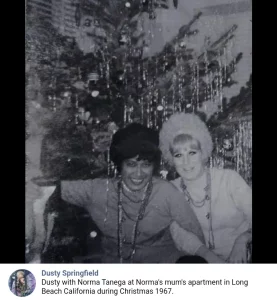
PARADE OF LOVERS
Dusty started churning through women beginning in the mid-sixties. In 1966 Springfield met American singer Norma Tanega, a Mexican-American singer, painter and activist. The couple fought just as hard as they loved. “I can’t tell you how many times I got that phone call at three in the morning,” said one of Dusty’s friends. “Get over here, Cat’s trying to kill me!” (Cat was Norma’s pet name for Dusty). Or, “John, come quick, Norma’s trying to kill me!” Dusty was prone to having flings behind Norma’s back. “I don’t mean that I leap into bed with someone special every night, but my affections are easily swayed and I can be very unfaithful. It’s fun while it’s happening, but it’s not fun afterwards because I’m filled with self-recriminations. The truth is I’m just very easily flattered by people’s attentions, and after a couple of vodkas I’m even more flattered.” She added, “I suppose to say I’m promiscuous is a bit of bravado on my part. I think it’s more thought than action. I’ve been that way ever since I discovered the meaning of the word. I used to go to confession and tell all my impure thoughts.”
Norma Tanega left Dusty in the early 70s when she found their relationship too difficult to sustain. According to Tanega, Dusty “wanted to be straight and she wanted to be a good Catholic, and she wanted to be black.” Springfield owned that while she was brought up Catholic, she no longer went to Mass. “It’s about six years since I made my Easter Duties. My mother’s going to love this. I still think that because I don’t go to Confession I’m going to go to hell but I haven’t done anything evil. I’m just lazy and self-indulgent.”
After Norma, Dusty began a string of on and off relationships, short affairs and one-night stands. From 1972-1978, she saw Faye Harris, an American photojournalist. In the 70s she was linked to the tennis pro Rosie Casals, although Casey’s said they were close friends, not lovers. There was a woman in Australia that shoved Dusty into a hotel fountain during a fight. In 1968, while recording her masterpiece album, “Dusty in Memphis,” she had a torrid affair with a woman named Sandy, drinking and partying so hard that she lost her voice. During the same trip, Dusty got into a fight with Sandy or another woman, which ended up with a TV in the hotel’s swimming pool at 4 am. One of them had picked up the TV and thrown it at the other. It went out the window and down 14 floors into the pool. One woman called the police on Dusty saying she had drugs. “As it happens I know who tipped them off,” she said. “There was a rather hysterical lady who was upset because I didn’t fancy her.”
In 1970 she gave an extremely brave interview to Ray Connolly in London’s Evening Standard, talking about her rumored attraction to women. “There’s one thing that’s always annoyed me, and I’m going to get into something nasty here. But I’ve got to say it because so many people say it to my face. A lot of people say I’m bent, and I’ve heard it so many times that I’ve almost learned to accept it. I don’t go leaping around to all the gay clubs but I can be very flattered. Girls run after me a lot and it doesn’t upset me. It upsets me when people insinuate things that aren’t true. I couldn’t stand to be thought of as a big butch lady. But I know I am perfectly capable of being swayed by a girl as by a boy. More and more people feel that way and I don’t see why I shouldn’t.”
THE OBSCURE YEARS
Dusty Springfield’s honesty came at a price— her popularity waned and she didn’t have a hit single for another 15 years. By the early 70s her stardom was over, and during the next decade and a half she faded into obscurity in LA as her fortune and career ebbed away. In 1972, Dusty had decided to flee the English press and move to California. The move left her short of money and without the support network she had in London. Her alcohol and drug use increased, and she found herself caught in an alcoholic haze that’s still too familiar to lesbians and gays torn between the closet and the need to live honestly. “When I knew Dusty, unfortunately, she was a mess,” said a lesbian business owner in LA who had a brief affair with her. “She was a very fragile, brilliant, special person—the sweetest, nicest person you could ever know. But she was also the most insecure person who ever lived. She was drinking, using, and slitting her wrists. She was so vulnerable.”
In the mid-seventies Dusty plucked up the courage to tell her parents that she was a lesbian—only to have it dismissed as unimportant or a joke. She was devastated by their reaction not to take her seriously. By then, her drug use was out of control, her love life reduced to a string of short-lived affairs, the sales from her recordings were low, and her royalties reduced to a trickle. She was often between stays in rehabs and hospitals. But she had yet to reach her lowest point.
DEMONS, DRUGS AND ALCOHOLISM
In 1974, Springfield’s mother passed away. This brought her to a deep mental low. Her lover, Sue Cameron, said that Springfield would sit on the floor and hallucinate about demons. “She would scream a lot,” Cameron said. “She’s say, “Demons! Demons! They’re coming to get me! – over and over again. “She’d also threaten to harm herself. She said when she cut herself she knew she was alive, because she could feel it.” A succession of psychiatrists confirmed that Dusty was struggling not only with alcoholism but also mental illness; depression and bipolar disorder. She also attempted suicide multiple times. Cameron ended her relationship with Springfield when Dusty chased her with a knife. “I will never know whether she intended to hurt me or not,” Cameron said. “She was laughing at my terror as she came toward me, teasing me by thrusting the knife closer and closer as I backed up. In my heart I think she was playing a sick game that was almost out of her control. I ran out of there to save myself.”
In 1981, Dusty met Carole Pope of Rough Trade, a Toronto-based rock band known for their provocative lyrics. Their 1981 hit, “High School Confidential,” was one of the first explicitly lesbian-themed Top 40 hits in the world.
“She’s a cool blonde scheming bitch, She makes my body twitch. Walking down the corridor. What’s her perfume? Tigress by Faberge. She makes me cream my jeans when she comes my way.”
In 2000, Random House published Pope’s autobiography, Anti Diva. The book detailed Pope’s relationship with Springfield, how they met and first had sex. “My manager, Vicki Wickham, thought that Dusty and I should meet. I heard stories Vicki told about Dusty, and she sounded like a handful, but Vicki believed that you could have any woman you wanted if you put your mind to it. Her mantra, “Every Bird is pullable,” had become part of my philosophy. So, in the fall of 1980 I flew to New York to meet the Queen of the Mods and see her perform at a supper club called the Grand Finale. Vickie came with me. The place was packed with Dusty fanatics and celebs; the audience included Rock Hudson and Helen Reddy, the singer of “I am Woman.”
“My first words were, “Vicki suggested we meet.” Dusty looked at my shyly and smiled. We started to talk and joke around, and within minutes were flirting madly with each other. In the middle of our dance of seduction, Helen Reddy came backstage with her husband. Dusty and I turned to each other and said, after they left, “Why is she married? She seems like a big dyke.”
Some months later, Dusty invited Carol to see her at the Montreal Ritz-Carlton. “I tentatively knocked on the door of Dusty’s suite. She answered, then stepped back into a rococo décor accented with heavy black and gold wallpaper. She seemed shy and unsure, and she was not alone. Her assistant—a girl draped in peals who epitomized the meaning of the word preppy—was introduced as Westchester. She discreetly left the room. Yes, the air was thick with sexual tension. She offered me a drink, and the next thing I knew we were all over each other. We tumbled into bed, half-naked. It was the first time I’d been with an older woman. Dusty had several years on me, and I found the idea very erotic. I fixated on her sensual mouth and unfathomable eyes. The most erotic thing we ever did in bed was this: I would beg Dusty to sing to me. She would put her mouth up to my ear. Then the sound of her voice, so intimate and so close, would wash over me in waves of pure pleasure.
Carol Pope asked Dusty to sing background vocals on a song, “The Sacred and the Profane,” she wrote for Rough Trade’s 1981 album, “For Those Who Think Young.” “Under the influence of Dusty—my twisted Catholic girl—my brain was inundated with images of Fellini films and Catholic morality.”
The hairdresser teaser her coif
With his tail comb
She has the tortured look of a Magnani
Constantly hounded by the paparazzi
The blood of Rome runs through her veins
She’s frightened by her overactive hormones
Mondo Italiano La Dolce Vita
Lust is written all over her face
She loves the smell of danger…
The fury of fallen angels
The aspirations of saints
The sacred and the profane
The relationship between the two started to erode the first time Carol had to take Dusty to the emergency room. “Dusty had taken some pills, coke, and God knows what else.” Carol took the knife out of Dusty’s hands when she started to cut her arms. “I tried to ignore the faded scars on her arms…What kind of self-loathing drove her to it?…Dusty was mainly silent about her past and the origin of her demons.”
“We broke up in LA. I told her I was being torn apart by her behavior. She was lost and I cared deeply about her, but she was fucking up my life. Dusty was very sweet, and resigned to the outcome. A few months before she died, Dusty called Carol to apologize. “She said, “I’m sorry for the way I behaved when we were together. You know I loved you.”
Dusty started to attend Alcoholics Anonymous meetings to help her deal with her drinking. She met actress Teda Bracci at an AA meeting in 1982 and they moved in together in April 1983. Bracci recalled that during a trip to Rome Dusty kissed her on a balcony overlooking the Vatican in defiance of her faith. 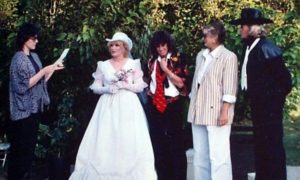
The two women wed at the end of 1983, exchanging vows in a backyard ceremony in LA’s San Fernando Valley. A lanky and vivacious brunette, Bracci appeared in some action films: a biker chick in CC & Company with Joe Namath and Ann Margaret; a prison inmate in a few episodes of Falcon Crest, a popular TV soap opera; a female lead in the LA premiere of Hair; and headlined in famous Sunset Strip rock clubs like The Troubadour and the Whiskey-A-Go-Go. The “best lady” at the wedding ceremony said Dusty wore a formal wedding gown, and the other bride wore a pants outfit with a vest and tie. Dusty was trying to stay sober, so anyone who wanted a drink would need to retrieve a bottle of Jack Daniels that hung from a rope outside the bathroom window. “Everyone seemed happy and peaceful that day,” the best lady said.
But like her other relationships, her marriage to Bracci quickly deteriorated into drunken violence. In one incident, Dusty menaced Bracci with a broken cup and slashed her leg. Bracci responded by hitting Dusty repeatedly in the head with a boot.
The last straw came on a day when Dusty was drinking wine and taking Valium. Teda returned to their apartment and the inevitable fight ensued. Bracci hit Springfield in the mouth with a saucepan and her teeth were knocked out. A plastic surgeon was able to patch her up, but damage to her face was permanent. The couple separated, and by 1987 Dusty headed back to Britain and a revival of her musical career.
BREAST CANCER
Dusty recorded several songs with the Pet Shop Boys, including the hits, “What Have I Done to Deserve This,” (1987) and “Nothing Has Been Proved,” (1988). In 1994, during work on her last album, “A Very Fine Love,” Dusty discovered she had breast cancer. Although her initial treatment was successful, the cancer returned and she died on March 2, 1999, in Henley-on-Thames, Oxfordshire, one month short of her 60th birthday. She had a Catholic funeral Mass in St. Mary the Virgin Church. Her casket was brought to the church by a horse-drawn carriage as she requested, and “You Don’t Have to Say You Love Me” was playing as her casket was carried into the church. Hundreds of fans and people from the music business attended her funeral, including ex-lover, Carol Pope.
In her last interview with the New York Times, Dusty said she would be very happy if her life took her back to Ireland. Her brother Tom, honored her wish and scattered a portion of her ashes near her favorite spot, the Cliffs of Moher. The rest of her ashes are buried under a granite marker in St. Mary the Virgin churchyard in Henley.
In the months before her death, Dusty reflected on her life with two of her friends. Lee Everett-Akin was the widow of gay DJ Kenny Everett. Like Dusty, he was raised Catholic, and that formation stayed with him throughout his life. “Being “outed” was one of her greatest fears. She just felt that she would be rejected by everyone if her secret came out. “We had a great affinity around her sexuality because Kenny felt exactly the same way. He was terrified of people finding out. They were very similar people, in that they were both brought up strict Catholics and that brought with it an awful lot of guilt.” Lee added that one of Dusty’s biggest regrets toward the end of her life was that she never settled down with someone. “She had so much love to give, even though she knew she was impossible to live with. She would say, “My life would’ve been so different if I’d had a good relationship.” Lee Everett-Akin had tried to persuade Dusty to write her life story, but Dusty told her she couldn’t remember most of it because of drugs and drinking. “The saddest thing of all,” Everett-Akin said, “was that when she was dying she told me she was embarrassed by her life, by the drinking, the failed relationships. She felt she had made so many mistakes in her life.”
Lee Everett-Akin’s comments echoed those of another close Dusty friend, Simon Bell, who moved in with her for the last 14 months of her life. “There were certain things she was addicted to, like the drink and the drugs and indeed relationships, that she eventually learned she just couldn’t have, said Bell. “She was never totally comfortable with the fact that she was a lesbian. She was very open privately with me but I think her Catholic background stayed with her right to the end and she never completely came to terms with it.”
MY LANGAN LOVE
The anger and the sadness of being a gay or lesbian Catholic always remains. Allies in local parishes, sympathetic clergy, and the large poll numbers of Catholics who believe their LGBT brethren should be treated fairly and respectfully encourage our belief that we truly belong; but the words we heard growing up and as young adults—that we were sick, our desires were twisted, that God, Jesus and the Church were against us—still resonate in our memories and emotions.
Despite all the negativity and doubt, there are times when we feel at home—with a place, in a song, with ourselves. In a YouTube video search of Dusty singing, I chanced on a clip of her performing “My Lagan Love” during a 1967 TV show. It is an old Irish ballad. “People get the idea,” she starts, “that all Irish songs are either “Paddy McGinty’s Goat” or “When Irish Eyes are Smiling,” all those lovely sorts of Hollywood Irish songs. Actually, the most beautiful ones I’ve ever heard are played by a very old gentleman somewhere in Donegal…The song that impressed me most of all was the one I’m going to attempt to sing for you now, called My Lagan Love.” A harper accompanied Dusty, who played an acoustic guitar. 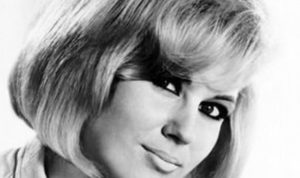
My Lagan Love
Where Lagan streams sing lullabies
There blows a lily fair.
The twilight gleam is in her eye,
The night is on her hair.
And like a lovesick Lennan-shee
She hath my heart in thrall.
No life have I, no liberty,
For Love is Lord of all.
And often when the beetles horn
Has lulled the eve to sleep
I’ll steal into her shelling lorn
And through the doorway creep.
There on the cricket’s singing stone,
She makes the boxwood fire
And sings in sweet and undertone
The song of hearts desire.
Her welcome, like her love for me,
Is from her heart within.
Her warm kiss is felicity
That knows no taint of sin.
And when I stir my foot to go,
‘It’s leaving Love and light,
To feel the wind of longing blow
From out the dark of night.
Dusty’s performance was shy and humble, which made her rendition of the song even more piercingly beautiful. The verses of anticipation, desire, love and longing were authentic; not the covert references to love in her Top 40 hits. Dusty was fully at home and in peace in the love song, and it was beautiful to hear, see and experience.
Was Goya Gay?
I don’t think that Goya was gay, but he had an emotionally charged relationship with a close friend, a never-married businessman named Martin Zapater. They discussed masturbation and sent each other drawings of their penises in their letters. Martin Zapater y Claveria (1747-1803) was a wealthy Aragonese merchant and Enlightenment thinker. 
A new book, Goya y Las Mujeres, by Spanish art historian Natacha Sesena suggests that the painter had a homosexual relationship with Zapater. Letters written by Goya to Zapater at the height of Goya’s creative years have romantic and sexual undertones.
Goya, the artist who first painted a woman’s pubic hair (“La Maja Desnuda) in 1797-1800, had 20+ children, a wife and mistresses, and must have had some heterosexual leanings—but kept his emotional and intellectual intimacy for a friend from his youth, Martin Zapater. Goya was very private and reserved in his opinions, but spilled out his heart in his letters to his friend:
“My Martin, I am desperate to go with you because I like you so much, and we suit each other so well, and it’s impossible to find anyone comparable, and I imagine what my life would be like if we could be together and hunt and drink chocolate and spend the 23 reales I have in your company…it would be the greatest happiness in the world.” Some of Goya’s letters are signed “Yours and yours again, your Paco Goya” and “He who loves you more than you think.”
During an illness in 1790, Goya told Zapater that “with your portrait before me, it seems I enjoy the sweetness of being with you oh my soulmate I didn’t believe friendship could arrive to the stage I am now feeling.” 
Most passionate friendships, for women at least, are never consummated, and always remain in the realm of “sexual almostness.” Sexual almostness stimulates a heightened awareness of possibility, but also the boundaries that surround us. It could push an artist into daring realms—like painting pubic hair.
Ria Brodell’s Butch Heroes
I search for lesbians in history. There is very little historical record or literature on lesbians before the late 19th century. Imagine my delight in discovering Ria Brodell’s book, Butch Heroes. I am grateful that Brodell found and brought these women to life. I can’t identify with their assumption of a male role; although I certainly can appreciate their brave and adventurous lives.
What is interesting about these individuals is that all of them dressed and assumed a male “role,” i.e., a “butch.” Their lovers or wives assumed a female “role” in the partnership. Did the people in Butch Heroes feel that they needed to identify as a man because they wanted to have sex with other women? Did identifying as a male give them freedom to avoid the female role of keeping house and staying at home? Or both?
What Ria Brodell did with their book is to make an emphatic statement that lesbians, and gender nonconforming people, have always existed, found lovers, lived their lives with varying degrees of success, and some led exceptional lives. Much like today. Society’s degree of toleration has expanded in the last one hundred years, particularly in the past 20 years, but no lesbian or gender nonconforming person lives totally “out” without experiencing some form of violence. Just like the past.
Brodell uses a uniquely Catholic format to portray Butch Heroes. When they/them was growing up their aunt had a huge collection of holy cards, and they would look at them together. She would talk to Brodell about the various saints whose stories were depicted on the cards. “So when I started researching people for Butch Heroes, I immediately thought of holy cards. The way cards employ symbolism, their intimacy, colors, style, etc. was perfect. They elevate a person to reverence. They are used for remembrance. I want this for the Butch Heroes.” 
Ria Brodell started the Butch Heroes project in 2010 after creating the painting, Self Portrait as a Nun or Monk, circa 1250. “I was thinking about what my life would have been like had I been born into a different century. Joining the church, becoming a nun or monk, was one option for those who did not want to enter into a heterosexual marriage or conform to strict gender roles of their time. As a former Catholic, I knew that “homosexuals” were called to a lifetime of chastity or service to the church, but I supposed that queer people of the past must have found other ways to live, and I wanted to find out how they did so.” 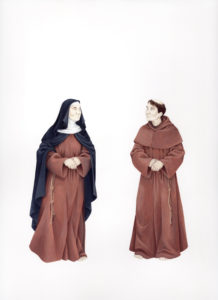
Prior to researching and painting Butch Heroes, Brodell blended sexuality, gender, role models, and Catholic childhood in The Handsome & the Holy, a series of self-portraits and vignettes she created from 2008-2010. “The Handsome & the Holy was the first time I tried to tackle the subject of my gender identity, sexuality and Catholic upbringing through painting,” Brodell said. “As a kid, part of me knew that something was “queer” about who I was attracted to, and who I wanted to be (Cary Grant, Ken, the Prince in all the Disney movies), but I didn’t have the language or the knowledge to understand what that meant. The way I wanted to express my gender did not mesh well with having to wear a little plaid skirt to school.”
Since I owned a Ken doll growing up I know exactly what she meant.
“When I began this series, I remembered a drawing I made for my First Reconciliation book in second grade. I had drawn a picture of St. Michael I was very proud of, and I showed it to my grandma. She told me it looked more like He-Man…Looking back now, He-Man and St. Michael had a similar appeal for me, strong warriors, fighting for good. As far as what unites movie stars, saints and toys like G.I. Joe and He-Man, for me they all represented an ideal, whether it was physical aesthetics or moral values. In combining them all for “The Handsome & the Holy” I was hoping to unite my “queer side” with my religious background because they are equally present in my life.”
One figure I’m surprised Ria Brodell left out was Saint Joan of Arc—who was burned at the stake for dressing like a man and hearing divine voices. I don’t know if she was a lesbian but dressing in armor certainly was outside the gender norms of 13th century French peasant girls.
Another candidate for a future Ria Brodell series would be St. Hildegund of Schonau (d. 1188). St. Hildegund was the daughter of a German knight. When she was twelve, she accompanied her father on a pilgrimage to the Holy Land. For her protection, she was disguised as a boy called Joseph. On the way home her father died. Hildegund/Joseph contained to maintain her identify as a boy then man. Back in Germany, Joseph was admitted to the Cistercian monastery in Schonau, where he remained until his death. 
Buy Butch Heroes here.
Closeted Killer – The San Francisco Doodler
THE KILLER
The Doodler, also known as the Black Doodler, was a gay serial killer active in the San Francisco area during 1974-1975. He killed at least six men and attempted to kill at least three others. The toll may be much higher. The man suspected of being the Doodler is still alive and living in San Francisco. The SFPD identified him as a person of interest, but don’t have enough evidence to charge him with a crime. Three survivors of his attack refused to identify him or talk to police. It was easier for them to almost die and risk others getting stabbed to death than ruin their lives and careers by coming out.
The Doodler got his nickname by his habit of sketching his victims prior to having sex and killing them. Based on one victim’s description, the Doodler was a black man, 19-25 years old, very lanky and around six feet tall. He often wore “a Navy-time watch cap.” He may have been an art student – he told one of the survivors he was “studying commercial art.”
The Doodler’s approach was to go to a gay nightclub or bar, sketch his chosen victim and use his sketch as a pick-up line. He would suggest they go somewhere private or isolated for sex. He would stab the man to death sometime during the sexual encounter. The Doodler left his sketches at the crime scene, although the police never released any of the sketches to the public.
No one knows exactly why the Doodler started killing in January 1974 or why he stopped in June 1975. The police believed that he had “mental difficulties involving sex,” or “sexual identification problems.” According to the San Francisco Chronicle, the Doodler told each victim: “All you guys are alike,” by which he meant gay. Detectives believe that the Doodler was a self-hating gay man, who killed during or after sex as a way of dealing with his own homosexual desires.
THE VICTIMS
The victims were white gay men, 27-66, that the Doodler picked up in bars and clubs for a sexual encounter. Each victim was stabbed or beaten to death. Most of the violence went well beyond what was needed to kill each man.
VICTIM #1 – Gerald Cavanaugh, 49.
Gerald Cavanaugh’s body was discovered at 1:57 am on January 27, 1974. He was lying at the edge of the water at Ocean Beach. He had been stabbed 16 times. A cut on his left hand indicated a defensive wound. Cavanaugh wore underwear, shoes, socks, pants, a shirt, a jacket, and a Timex watch. He had $21.12 in his pocket. He worked in a mattress factory. He was 5’ 8” and weighed 220 pounds. Cavanaugh was Catholic. “Never married,” noted the coroner.
Cavanaugh was born in Montreal, Quebec, Canada on March 2, 1923. He left home young and did a 21-month hitch with the US Army in World War II. He ended up in the Haight-Asbury section of San Francisco in the 1970s, to take advantage of the sexual freedom there and in the nearby Castro. He was not out to his family. He went home once a year to visit his mother until she died in 1967. After that, he never went back.
Police records show that Cavanaugh had been stopped by police, suspected of having sex in men’s restrooms near the foot of Ulloa Street at Ocean Beach. His body was found in the sand a short distance away. The anonymous call that tipped police to Cavanaugh’s body came from a pay phone at those restrooms.
His sister came from Canada to identify his body, but no one took Gerald Cavanaugh home after his murder. He lies under a weathered gravestone in the Holy Cross Cemetery in Colma, California, about 12 miles south of San Francisco.
VICTIM #2 – Joseph “Jae” Stevens, 27
Early in the morning of June 25, 1974, Jae’s body was discovered by a woman walking her dog. He was in the bushes by Spreckels Lake in Golden Gate Park, close to his car. He had been stabbed three times and there was blood in his nose and mouth. Joseph Stevens had been born in Texas but moved to San Francisco in his late teens. Stevens performed as “Jae,” a female impersonator at Finocchio’s, a nightclub in San Francisco. He was originally brought in as a replacement act but proved to be so popular that he quickly moved into gay stand-up comedy. One of his sisters described him as “Very, very talented. And again, gorgeous. Oh, my, we had such fun together, making up little shows while he was growing up and then later in clubs. I mean, he was a fantastic actor. And, oh, could he sing.”
Three months after his death, another sister, Alma Teresa Stevens, thought evil spirits had emerged from his murder. She killed their mother and burned her in the family fireplace. She attacked another sister and tried to kill her. The sister survived, but Alma ended up in an institution for the criminally insane. The people who purchased the family home said the mother haunts the house, but she is a friendly ghost. They talk to her and ask her to watch the house while they are away.
VICTIM #3 – Klaus A. Christmann, 31
Klaus or Claus Christmann, a German national, was last seen alive at Bojangles, a gay dance club in the Tenderloin district. He had been visiting friends in San Francisco for three months. His wife and two children remained in Germany. According to the coroner, “The deceased’s pants were unzipped and open,” supporting investigators’ theory that Christmann and the Doodler had gone to a quiet, private area for sex.
A dog walker discovered his body early in the morning on Sunday, July 7, 1974. He lay near a street leading from Golden Gate Park to Ocean Beach. His throat was slashed in three places, and he had been stabbed 15 times. At his death, Christmann wore a tan leather jacket, “black side zipper ankle boots with brown Cuban-heels, a white Italian shirt, orange bikini briefs, one blue moonstone ring and one brown cameo ring along with a gold wedding band.” The coroner also noted he had a tube of face paint in his pocket, which led police to speculate that Christmann may have been working as a drag queen or female impersonator in secret.
VICTIM #4 – Frederick Elmer Capin, 32
Frederick Capin was from Washington State, a decorated Vietnam veteran working in San Francisco as a registered nurse. He had been a medical corpsman in the Navy and was the recipient of a medal for saving four men under fire in Vietnam. His body was found on May 12, 1975, by a hiker behind a sand dune between Vicente and Ulloa Streets in the Outer Sunset neighborhood of San Francisco.
Capin, six-feet-tall and a lithe 148 pounds, had been stabbed 16 times in upper left chest. Capin’s corduroy jacket and multi-colored “Picasso” shirt were blood-soaked, and there was dried blood smeared over his face, hands, and blue jeans. The marks in the sand leading to Capin indicated his body had been dragged about 20 feet.
VICTIM #5 – Harald Gullberg, 66
Harald Gullberg was a sailor. He was born in Sweden in 1908 and became a naturalized American citizen on August 15, 1955. Half his teeth were gone and those remaining were rotted. Gullberg was a heavy drinker and was slowly dying from cirrhosis.
His body was found near Land’s End Trail by Lincoln Park Golf Course on June 4, 1975. Gullberg’s throat had been slashed. He had been dead about two weeks. Gullberg’s pants were unzipped, and he wore no boxers or briefs. He had $2.43 in his pocket. His face was eaten by maggots.
VICTIM #6 – Warren Andrews, 52
In January 2022, the San Francisco Police Department identified a sixth victim of the Doodler. Warren Andrews was a lawyer for the U.S. Postal Service. He lived in Millbrae, a suburb of San Francisco. Andrews was battered with a rock and branch and left for dead on the morning of April 27, 1975. His body was found in Land’s End park. His family flew him home to the Seattle area, where he lay in a coma until dying nearly two months later. A reporter tracked down Andrews’ sister. When asked if he was gay, she said, “I think he probably was…but back in those days, everybody was in the closet.”
THE SURVIVORS
Three men survived an attack by the Doodler. They saw his face, talked to him, may have even had sex with him. They were able to flee or get away before he killed them. The eyewitnesses described their attacker as a young, tall, slim black man.
SURVIVOR #1 – May 1975
A European diplomat met the Doodler in a restaurant “where he was having a midnight snack.” The Doodler asked the diplomat if he had any cocaine. They went back to the diplomat’s apartment, where the Doodler stabbed him six times. The diplomat denied they had “sexual relations.”
SURVIVOR #2 – July 1975
A “nationally known” entertainer took the Doodler back to his Fox Plaza apartment. The identity of this person has never been disclosed, although he might have been actor Rock Hudson or Richard Chamberlain, or singer Johnnie Ray. The identity of this survivor is one of the great mysteries of the case.
SURVIVOR #3 – July 1975
The third survivor was a “well-known San Francisco figure” who left the city after the attack and refused to answer calls or letters and wouldn’t help the police in their investigation. The man had brought the Doodler back to his Fox Plaza apartment, which happened to be on the same floor as the first attack two weeks prior. The late Charles Lee Morris, owner and publisher of the Sentinel, a San Francisco gay weekly, told a story about a Los Angeles man who was about to go to bed with a young black man resembling the composite sketch of the Doodler, but changed his mind when a knife fell out of the man’s pocket.
THE SUSPECT
In January 1976, the San Francisco Chronicle ran a story about the Doodler and two days later a suspect was arrested. A man who resembled the composite sketch was taken into custody after he entered a Tenderloin bar and offered to draw the patrons. Along with a book of sketches, he’d been carrying a butcher knife. When he was brought in for questioning he denied assaulting or killing anyone; but became so enraged during an interrogation that he attacked one of the detectives.
The man was let go, and never charged, because none of the three survivors would testify against the man in court. It would mean coming out of the closet and being revealed as gay. Without their cooperation, police couldn’t build a case. Gay rights activist and politician, Harvey Milk, said, “I can understand their position. I respect the pressure society has put on them.”
In 1977, the San Francisco Sentinel reported that a local psychiatrist practicing in the East Bay area informed police that one of his patients confessed to being the Doodler. The psychiatrist said his patient was struggling with his own homosexuality and was killing in response to his own conflicted feelings. The psychiatrist has the surname “Priest,” or may have been a priest. His identity was lost.
San Francisco Police confirmed in 2019 that the man suspected of being the Doodler was alive and still considered a person of interest in the case. In the 47 years since the Doodler’s last murder, many of the officers involved in the case have died, although one of the survivors may still be living. Susan Stryker, the author of Gay by the Bay: A History of Queer Culture in the San Francisco Bay Area mentions the case briefly. “The only people I found who remembered the killings were trans women who lived in the Tenderloin at the time,” she said. “It is a very poorly-remembered episode in SF LGBT history.”
Were there other serial murders of gay men in the late 70s and 80s in other cities in California or gay urban centers? In the case of the younger men, Klaus Christmann in particular, my theory is the Doodler savaged men with whom he was strongly sexually attracted. The older men, Gerald Cavanaugh and Warren Andrews, may have been of the age or physical resemblance of a man or men who sexually abused or took advantage of him when he was younger. The choice of a knife as a killing weapon is strongly evocative of an erect penis. It enters a body and takes control. He stabbed at the heart.
San Francisco Chronicle reporter, Kevin Fagan, resurrected this notorious serial killer case through his podcast, The Doodler, produced in partnership with Ugly Duckling Films and Neon Hum Media. Maybe the murderer will confess? Maybe the police have enough DNA to prepare a case? Sadly, I don’t think either one will happen and the Doodler will die a free man. Who is he? A friendly neighbor? A respected elder? A recluse in a shabby apartment with a dog-eared sketchbook?
Saint Thecla the Evangelist
A healthy number of saints’ stories feature people who were “called to chastity” or to a relationship with Christ vs. marriage. All kinds of fantastic legends and tales ensued about the lengths to which these people would go to avoid marriage and connubial sex. Ultimately, they were all successful in their quest to avoid sex with members of the opposite sex. They ended up living alone (rarely) or with a same-sex companion (often) or same-sex community in a wilderness setting (usually).
St. Thecla the Evangelist is one of those saints. She would face anything but marriage.
Thecla’s story is preserved in the Acts of Paul and Thecla, an apocryphal story of Paul’s impact on a young virgin, Thecla, and her subsequent trials, adventures and spiritual leadership as his disciple. She infuriated many Church Fathers, including Tertullian, who griped that some Christians were using the example of Thecla to legitimize women’s roles in teaching and baptizing.
According to Acts, Thecla was a beautiful young woman of Iconium (now Konya, Turkey) whose life was transformed when she heard St. Paul preaching in the street beneath her window. She announced her intention to break off her engagement and to embrace a life of chastity. Her finance was furious. Her family was scandalized. They denounced her to the governor who had her arrested and condemned to death. Thecla was tied naked to a stake, but a miraculous thunderstorm put out the flames. She is saved. Once home, Thecla disguises herself as a youth and escapes to reunite with Paul and travel to Antioch.
While traveling, she is sexually assaulted by Alexander, a prominent man of Antioch. One account reads: “Repulsing the assault, she tears his cloak and knocks the wreath from his head. Alexander (the would-be ravisher) brings her before the magistrate who, despite the protests of the women of the city, again condemns Thecla to death, this time ad bestias. Pleading to remain a virgin until her death, she is taken in by ‘a certain rich queen, Tryphaena by name,” who lost her own daughter. (Tryphaena was the widow of Cotys, King of Thrace and a great-niece of the Emperor Claudius. In Romans 16:12, Paul sends greetings to a Tryphaena.)
Thecla is allowed to return to Tryshaena. She rides a lioness (who licks her feet) and is paraded through the city. The next morning, Alexander comes for her and escorts her to the arena to die. There she is stripped and thrown to wild beasts. A lioness (presumably the one who licked her feet) protects her from the attacks of lions, bulls and bears. Thecla prays, and throws herself into a trench of water (an euripus) and baptizes herself. The water is full of ferocious and hungry seals. A cloud of fire covers her nakedness and kills the vicious seals. The women in the stands of the arena cast fragrant nard and balsam into the area, which had a pacifying effect on the remaining wild animals. The awestruck governor releases Thecla and she returns to the palace of Queen Tryshaena. Refusing all entreaties to stay with the queen, Thecla dresses in male clothing and sets out to find Paul. She tells him that she baptized herself, and had been commissioned by Christ to baptize and preach in his name. According to the story, Paul recognized her as a fellow apostle and encouraged her to preach the Gospel. Wherever she went, “a bright cloud conducted her on her journey.”
Thecla encouraged women to live a life of chastity and to follow the word of God. She returned home to find her finance had died and her mother indifferent to her preaching. She left, and in one version of her story, she dwelt in a cave in Seleucia Cilicia (southern Turkey) for 72 years and formed a monastic community of women, whose members she instructed “in the oracles of God.”
In another version, Thecla passed the rest of her life in a rocky desert cave in the mountains near the town of Ma’aloula (Syria). She became a healer and performed many miracles. She remained persecuted, and men still conspired to rape and kill her. Just as she was about to be seized, Thecla cried out to God for help. A fissure opened in the stone walls of her cave and she disappeared. It is said that she went to Rome and lay down beside Paul’s tomb.
Her cave became an important pilgrimage site in early and medieval Christianity. Today visitors can still see Thecla’s cave and the spring that provided water for her. The nuns who live at the Mar Thecla monastery will tell you her story and show you the opening in the rock where the saint escaped.
There are many wonderful parts of St. Thecla’s story, beginning with her determination to live her life following her calling to evangelize, rather than accede to family or societal expectations. Her protection by animals, the public affirmation by groups of women, are also very positive. She was unashamed of her nakedness when she was led twice to the arena to die. She was proud of her body, her virginity, and her sole possession of it. The biggest surprise was her encouragement by St. Paul ( wives-be-subordinate-to-your-husbands), accepting her as a fellow apostle. The ugly, horrifying constant throughout her life is the desire by men to rape Thecla or kill her if she won’t submit to their authority. Men who are rapists do not believe that they are the problem–females (or males) who aroused them are at fault. What can Christianity do to change this perception?
Charlotte Mew’s Fearful Longings
“Charlotte Mew: Madness and Sapphic Desire,” by Rebecca Batley introduced me to this slightly mad, brilliant, and reclusive poet. Almost immediately she reminded of some closeted Catholic lesbians that I have met. These women longed for love and sex but were fearful of acting on their desire. They were afraid of losing their respectability; and the tension between their religious faith and sexual need filled them with dread and a sense of loss. No wonder they were a little unhinged. Deeply closeted women often don’t read signs well, and can fixate on women who aren’t interested in them. This results in a predictable rejection. 
Charlotte “Lotti” Mary Mew was born on November 15, 1869, in London, England. Several of Mew’s siblings suffered from mental illness and were committed to mental institutions. This scared Charlotte and her remaining sister Anne, so much that they made a pact never to marry. In 1898, their father died without leaving any money for the family. This forced the Mews to rent out part of their home, and Charlotte took a job.
As a schoolgirl, Charlotte fell in love with her headmistress, Lucy Harrison. Harrison herself fell in love with a teacher named Amy Greener, and they moved away. Mew had two other serious crushes: the writer Ella D’Arcy in 1898 and popular novelist and suffragette May Sinclair nine years later. Her loves were unrequited. There is no information on whether Charlotte’s physical longings were ever consummated with anyone, but her poem, There Shall Be No Night There describes a tender fantasy:
“Then through my blood the coming mystery
Of night steals to my heart and turns my feet
Toward that chamber in the lamp-lit street,
Where waits the pillow of thy breast and thee.
‘There shall be no night there’—no curtained pane
To shroud love’s speechlessness and loose thy hair
For kisses swift and sweet as falling rain.
What interested me the most about Charlotte Mew was the tension between her religious belief and her lesbian desire. Tensions and strains between our physical and spiritual selves have ripped apart, wounded, or maimed many lesbians. Charlotte Mew was no exception. Does God love me for who I am and what I am? Many lesbians have concluded that the answer is “No,” and leave religion to end their isolation and painful loneliness. Mew stuck with religion but suffered. She believed, but she also carefully coded her desires and doubts in her poetry:
“I think my body was my soul,
And when we are made thus
Who shall control
Our hands, our eyes, the wandering passion of our feet,
Who shall teach us
To thrust the world out of our heart: to say, till perhaps in death,
When the race is run,
And is forced from us with our last breath
“Thy will be done”?
“Madeleine in Church” by Charlotte Mew (1916)
In 1926, her sister, Anne, was diagnosed with cancer. Charlotte took care of her until she died in 1927. After her sister’s death, she became deeply depressed and entered a nursing home. She committed suicide by drinking Lysol, a disinfectant. Charlotte Mew died on March 24, 1928, at the age of fifty-eight. 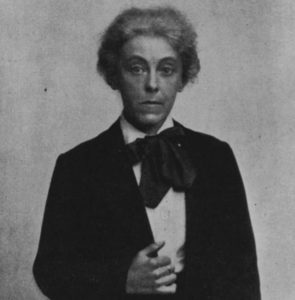
Charlotte Mew is buried with her sister Anne in Hampstead Cemetery, West Hampstead, London. The epitaph reads, “Cast Down the Seed of Weeping and Attend.” The phrase is from The Divine Comedy by Dante Alighieri, translated by Henry Wadsworth Longfellow, Vol. II (Purgatorio), Canto XXXI (31). Dante meets his ladylove, Beatrice, and recalls his love for her. She admonishes him.
“Cast down the seed of weeping and attend;
So shalt thou hear, how in an opposite way
My buried flesh should have directed thee.”
“Never to thee presented art or nature
Pleasure so great as the fair limbs wherein
I was enclosed, which scattered are in earth.”
The dismal reproach to follow a “higher good” instead of human love followed poor Charlotte Mew to her grave.
I wish instead to provide her and her work and art a happier ending, inspired by Psalm 126:6 –
“Those who go forth weeping,
Carrying sacks of seed
Will return with cries of joy,
Carrying their bundled sheaves.”
Almost 100 years after Charlotte Mew’s death, there are lesbians of faith who are married, enjoying the physical delights of a loving relationship, and looking forward together to the promise of salvation and eternal life.
The Farmer’s Wife, a poem by Charlotte Mew read by Tom O’Bedlam
Andy Warhol’s Catholic Influences
Andy Warhol is an influential and celebrated 20th century artist and pop icon. He was gay and was raised Catholic. His faith and sexuality influenced his art. As an adult, he did attend church from time to time, especially after he was shot and almost killed in 1968 by Valerie Solanas, a writer and radical feminist.
“Revelation” an exhibit at the Brooklyn Museum from November 19, 2021 to June 19, 2022, features Warhol artworks that are infused with both strains, often harmoniously and deeply revealing. The show was developed by the Andy Warhol Museum’s chief curator, Jose Carlos Diaz and curated at the Brooklyn Museum by Carmen Hermo.
Some of the show’s highlights include Warhol’s two gigantic versions of “The Last Supper” in pink and yellow; and a fusion of the face of Christ, an advertising tagline, and a shirtless young man; and a shot-up, scarred Warhol reminiscent of Christ’s wounds or a martyred St. Sebastian.
Much of Catholic dogma, art and religious expression is focused on the body. The sacrament of the Eucharist—eating and drinking Christ’s body—can have sexual overtones. Human figures in Catholic art history are often beautiful men, some in sexually suggestive poses. These influences went into Warhol’s formation as an artist and as a man, and he combined them with the pop arts trends of the day. Catholicism has inspired generations of homosexual artists through its sensual and sexually charged imagery. 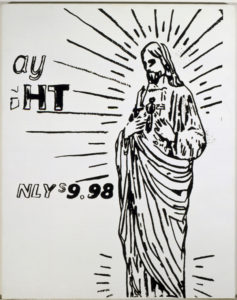
The Mob Behind Dog Day Afternoon
“I’m a Catholic and I don’t want to hurt anybody. Understand!” yelled Sonny Wortzik, the bank robber played by Al Pacino in the memorable 1975 movie, Dog Day Afternoon. Pacino’s character was based on John Mojtowicz, 27, who along with 18-year-old Salvatore Naturile, and Robert Westenberg, attempted to rob a Chase Manhattan branch in Gravesend, Brooklyn on August 22, 1972. Westenberg fled when he saw a police car. All three men were gay. The night before the robbery they all had sex together at the Golden Nugget Motel.
In the movie, the main reason for the heist was to get money to pay for a male-to-female sex change operation for John Wojtowicz’s wife. That may have been part of Wojtowicz’s stated reason, but was it the whole truth? According to Liz Eden (born Ernest Aron), Wojtowicz’s transgender wife, Wojtowicz owed the Gambino family money. Some of that money went to pay for their December 1971 wedding, where they were married by a Roman Catholic priest. Liz Eden wore a wedding gown; John Wojtowicz his Army uniform and medals from the Vietnam war.
According to the FBI, Wojtowicz met Naturile a month prior to the robbery at a gay bar called Danny’s, located on Seventh Avenue South in the Village. Naturile agreed to participate to get money to rescue his two sisters from foster care. The guns used in the robbery supposedly came from Mike Umbers, 37, a Gambino family associate who ran a club, bar and bookstore in the West Village. Umbers fronted several gay bars, callboy rings and pornography operations for the Genovese and Gambino organized crime families. Wojtowicz was friendly with Umbers, much to the chagrin of his fellow Gay Activist Alliance (GAA) members. Wojtowicz was known as “Littlejohn Basso” (Basso was his mother’s maiden name) at GAA.
On August 26, 1972, this article about Wojtowicz’s Brooklyn heist appeared in the New York Times:
“An acquaintance of John Wojtowicz—who has been charged with robbing a Chase Manhattan branch in Brooklyn last Tuesday and holding nine persons hostage—reportedly told the Federal Bureau of Investigation yesterday that an underworld figure supplied the guns used by Wojtowicz and two accomplices in the holdup.” “The acquaintance, Gary Badger, was questioned by F.B.I. agents yesterday afternoon, but the bureau would not comment. A friend of Mr. Badger, however, said that he told the agents that five men, including Wojtowicz, began planning the robbery last April, but that two of the men later bowed out. Wojtowicz was pressed to carry out the robbery by the underworld figure, who owns Greenwich Village bars and is involved in pornography, Mr. Badger reportedly told the agents. Mr. Wojtowicz owed the gangster money, he said.” Arthur Bell, a respected Village Voice columnist and investigative reporter, interviewed Badger, who showed up at a GAA meeting to make a plea for money to help bury his friend, Sal Naturile.
Arthur Bell knew Wojtowicz through GAA meetings and dances. He interviewed Wojtowicz and published an article about the robbery in the August 31, 1972 edition of the Village Voice, “Littlejohn and The Mob, Saga of a Heist.” Wojtowicz described how he met a middle-aged Chase Manhattan bank executive at Danny’s. The executive told him how he could rob the branch of $150,000 to $200,000. The money in the bank’s safe was picked up early; so instead of the big payday only $29,000 was on hand.
Bell also knew Mike Umbers, and interviewed him in 1971, a year before the robbery. The article, “Mike Umbers: Christopher’s Emperor,” described his start in the sex business; first as a pimp for high-class call girls and brothels, and then catering to gay men. Umbers had his run-ins with police and other crime families. According to the article, “Corruption, Before and After Stonewall,” Mike Umber’s Christopher’s End club was trashed by police. It was possible that police destroyed the interior with hammers and axes because Umbers wasn’t paying them off; or, the attack was ordered by Al Moss, also known as Abe Moss, who ran some gay bars for the Gallo crime family in the West Village.
I was interested to read that Al Moss had a nephew named “Red” who paid the police $2,000 a month to protect The Barn, an after-hours club on Hudson Street. “Red” may be a reference to Red Mahoney, a long-time associate of Ed Murphy, who had his own checkered past as a gay blackmailer and gay activist. Mahoney worked with Murphy when he was alive and took over running the Christopher Street Festival after Ed died in 1989. Mahoney ran the Festival until 1992, when he became ill and stepped down. Mahony was a short, grumpy guy with dark red hair. He didn’t have Ed Murphy’s gregarious nature or command the same respect.
The vast web of connections between the mob (Genovese, Gambino, Gallo crime families), their associates (Murphy, Mahoney, NYPD), front men (Umbers), expendables (Wojtowicz, gay hustlers) and gay clubs and bars before and after Stonewall continues to amaze me. The connections were essential to their multi-million dollar businesses of bars, clubs, pornography, prostitution and blackmail.
Was the middle-aged Chase Manhattan executive who tipped off Umbers and Wojtowicz being blackmailed?


